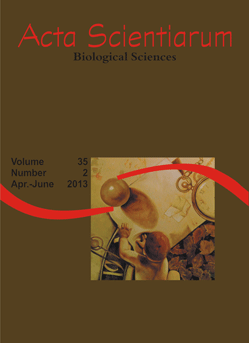<b>Population parameters of the shrimp <i>Xiphopenaeus kroyeri</i> (Heller, 1862) (Crustacea, Penaeidae), caught by artisanal fisheries in Anchieta, Espírito Santo State</b> - doi: 10.4025/actascibiolsci.v35i2.13408
Abstract
The fishery on Penaeidae shrimp is done all over the Brazilian coast, especially the seabob shrimp (Xiphopenaeus kroyeri). It is captured in large quantities in the Southeast and Southern Brazil. In order to study the population structure of X. kroyeri from Anchieta Municipality, Espírito Santo State, during the period from January to December 2008, monthly samplings with one-hour-long were conducted to verify the number of individuals, biomass, sex, total length and gonad maturity stage. The specimens had total length ranging from 2.96 to 9.96 cm, and females were larger than males. It is suggested that the population of X. kroyeri presents patterns of recruitment and reproduction similar to those of the Northeast region. The estimated size of first gonadal maturation was 4.5 and 6.9 cm for males and females, respectively. The fishing operates on a stock composed of predominantly adult males and juveniles and adult females. The mesh size of the nets and the high plant biomass in the fishing areas may be contributing to the increased catch of juveniles, undermining the recruitment of X. kroyeri.Downloads
Download data is not yet available.
Published
2012-12-20
How to Cite
Eutrópio, F. J., Mariante, F. L. F., Ferreira Junior, P. D., & Krohling, W. (2012). <b>Population parameters of the shrimp <i>Xiphopenaeus kroyeri</i> (Heller, 1862) (Crustacea, Penaeidae), caught by artisanal fisheries in Anchieta, Espírito Santo State</b> - doi: 10.4025/actascibiolsci.v35i2.13408. Acta Scientiarum. Biological Sciences, 35(2), 141-147. https://doi.org/10.4025/actascibiolsci.v35i2.13408
Issue
Section
Aquiculture and Fisheries Resources
DECLARATION OF ORIGINALITY AND COPYRIGHTS
I Declare that current article is original and has not been submitted for publication, in part or in whole, to any other national or international journal.
The copyrights belong exclusively to the authors. Published content is licensed under Creative Commons Attribution 4.0 (CC BY 4.0) guidelines, which allows sharing (copy and distribution of the material in any medium or format) and adaptation (remix, transform, and build upon the material) for any purpose, even commercially, under the terms of attribution.
Read this link for further information on how to use CC BY 4.0 properly.
0.6
2019CiteScore
31st percentile
Powered by 

0.6
2019CiteScore
31st percentile
Powered by 











1.png)




3.png)













